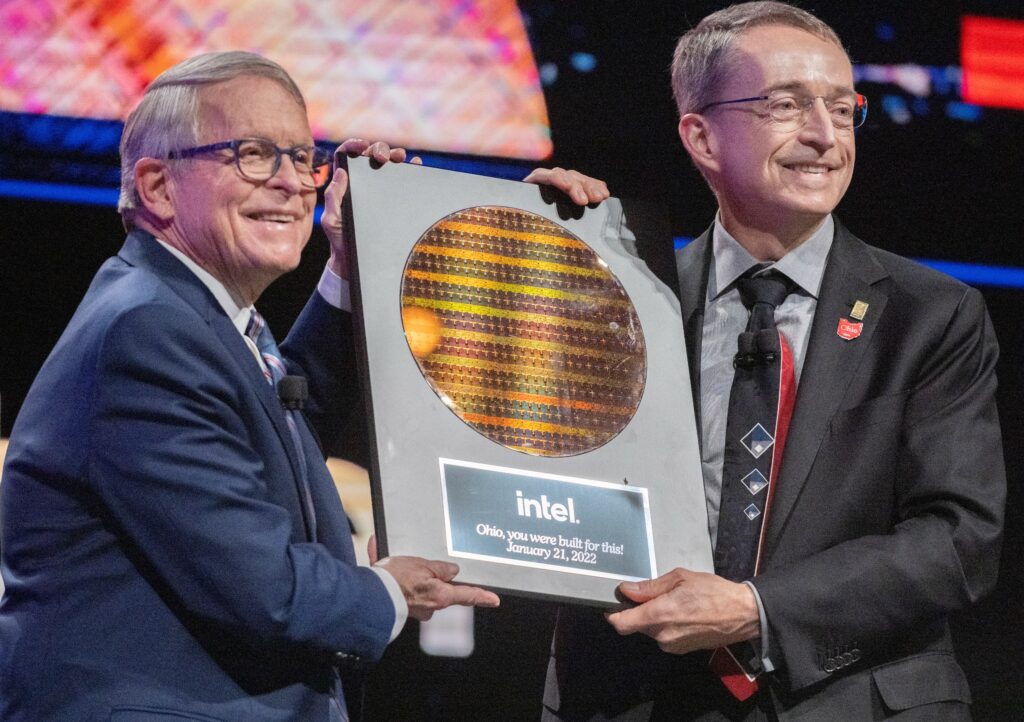The world’s leading semiconductor makers are having a hard time keeping up the with the global demand for computer chips, a shortage that is forecast to last through at least the end of the year. The U.S. – which accounts for just 12% of global chip production right now – relies heavily on foreign suppliers. That is about to change.

Intel, the world’s largest chip maker, is striving to increase American chip production and is betting big on Ohio, investing $20 billion to build two new chip sites in Licking County, outside Columbus. These facilities are the company’s first new manufacturing sites in 40 years.
Intel CEO Patrick Gelsinger and Ohio Governor Mike DeWine, in announcing the plan, called it the largest single private sector investment in Ohio’s history. Expansion may grow to eight factories on the complex as the semiconductor industry lobbies Congress for subsidies.
Construction is slated to start later this year. In its press release, Intel notes, “The new site will be designed and constructed with green building principles, and the new factories have a goal to be powered by 100% renewable electricity and to achieve net positive water use and zero total waste to landfill in support of Intel’s 2030 sustainability goals.”
Impactful Job Creation
It’s estimated there will be a need to fill 7,000 construction jobs to build the manufacturing facilities, and Intel plans 3,000 direct hires with some openings already posted.
“From internships to entry-level technician positions and opportunities for experienced engineers, supply chain professionals and more, Intel’s advanced semiconductor manufacturing facilities will create thousands of high-tech, high-wage jobs and opportunities in Ohio,” says Christy Pambianchi, Intel’s executive vice president and chief people officer, in a statement provided to WorkingNation. She adds, “We want Intel to be one of the best places to work in the region.”
The Intel facilities are also expected to support tens of thousands of additional local jobs across an ecosystem of suppliers and partners.
Creating a Talent Pipeline
The average salary for these Intel jobs will be $135,000, according to the company, and include a wide range of roles, requiring backgrounds from those with an associate degree to a Ph.D.
Finding talent may not be a simple task. The semiconductor industry, overall, is experiencing a labor shortage.
To address that challenge, Intel is investing $100 million for training and education to develop a talent pipeline and research programs, in partnerships with institutions.
Part of the reason for choosing Ohio, according to Intel, is the access to dozens of the state’s public and private colleges and universities, and community colleges.
The Ohio State University, for one, has already added a B.S. degree in engineering technology – with a manufacturing concentration – as it prepares students for the semiconductor industry. It will be working with the Ohio Department of Higher Education and other institutions to train faculty and develop curriculum.
The Role of Community Colleges
Central Ohio Technical College (COTC) expects to be among the community colleges providing talent as it has campuses close to Intel’s planned complex. “We know we are going to need to be a major supplier and a major partner in this process,” says John Berry, Ph.D., COTC president. He says there will be collaboration with Intel and education partners to develop the curriculum for an associate degree.

“We will need to make sure that what Intel wants and needs here in central Ohio is what we are capable of producing at a scale that we probably haven’t produced before,” adds Berry.
Berry says COTC will be looking for guidance from programs at community colleges in Arizona and Oregon where Intel has chip factories.
One example of an Intel position that will be available to people with an associate degree is a manufacturing technician.
Transformational Opportunities
“The rubber is really going to have to meet the road,” says Eric Heiser, Ph.D., COTC provost, referring to the role his institution will need to play.

Heiser says the opportunity for community college students to earn six-figure salaries for some upcoming Intel jobs is rare. “It likely will not happen again in our lifetimes,” he says. Many students at COTC are the first in their families to attend college, notes Heiser, and Intel’s investment has the potential to “change multiple generations of families.”
He says there will also be additional opportunities with other employers, including distributors.
“It’s every bit transformational for this community and will absolutely color the history of this area for many, many years to come,” says Heiser. “We’ve got to get this one right.”











